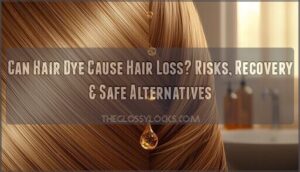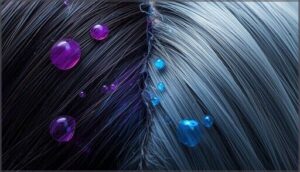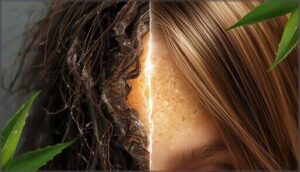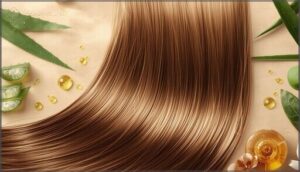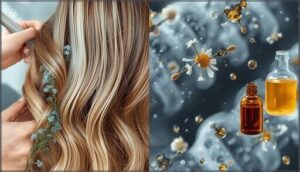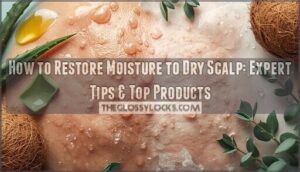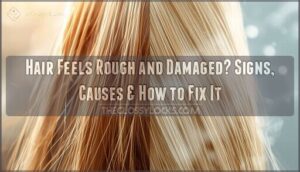This site is supported by our readers. We may earn a commission, at no cost to you, if you purchase through links.
You might notice more hair in your shower drain after coloring, but that doesn’t always mean you’re going bald. Hair dye can damage your strands, yes—but the real question is whether it’s harming your follicles or just breaking weakened hair. The difference matters because one grows back easily, while the other requires intervention.
Chemicals like ammonia and peroxide strip away protective proteins, and for some people, ingredients such as paraphenylenediamine trigger allergic reactions that genuinely threaten hair growth.
Understanding what’s happening beneath your scalp—and knowing which products pose real risks—helps you protect your hair without giving up color entirely.
Table Of Contents
- Key Takeaways
- Can Hair Dye Really Cause Hair Loss?
- Why Hair Falls Out After Dyeing
- Ingredients in Hair Dye That Cause Damage
- Will Your Hair Grow Back After Dye Damage?
- How to Promote Hair Regrowth After Dye Damage
- Preventing Hair Loss From Hair Dye
- Safe Hair Dyeing Practices and Precautions
- Natural and Safer Hair Dye Alternatives
- Frequently Asked Questions (FAQs)
- Conclusion
Key Takeaways
- Hair dye typically causes breakage rather than true follicle damage, meaning most shedding is reversible if you stop chemical treatments for three to six months.
- Paraphenylenediamine (PPD) triggers allergic reactions in up to 4% of users, and ammonia combined with peroxide can strip 85% of the structural bonds that keep your hair strong.
- You can protect your hair by choosing ammonia-free or plant-based dyes, performing a 48-hour patch test before every application, and spacing permanent color treatments at least four to six weeks apart.
- Professional application reduces scalp irritation by 22% and breakage by 25% compared to at-home kits because trained colorists adjust formulas to match your hair’s condition.
Can Hair Dye Really Cause Hair Loss?
You’ve probably heard mixed messages about whether hair dye actually causes hair loss, and the truth isn’t quite black and white. The answer depends on the type of dye you’re using, how your hair reacts to chemical processing, and what’s happening at the follicle level.
Let’s break down what’s really going on when you color your hair and how different dyes affect your strands and scalp.
Types of Hair Dye and Their Effects
Because each hair dye formula works differently, your hair’s reaction depends on what you choose. Permanent dyes use ammonia and peroxide to create oxidative effects that penetrate deep, often causing chemical damage to hair. Semi dyes coat the surface more gently, while natural alternatives like henna rarely trigger the harsh hair coloring side effects you might see with metallic dyes.
Understanding hair dye ingredients and effects helps protect your hair’s health. Choosing the right hair dye type is essential for minimizing damage and promoting healthy hair.
Hair Breakage Vs. True Hair Loss
When you spot shorter strands or find clumps on your brush, you’re likely seeing hair shaft damage, not true hair loss. Breakage snaps chemically weakened fibers mid-length, leaving uneven lengths and split ends, while genuine follicle health problems reduce density at the root.
Hair breakage patterns from dye show intact scalp openings and regrowth cycles that continue normally, unlike scarring scalp conditions or alopecia. Understanding hair dye effects is vital to addressing these issues.
How Dye Chemicals Damage Hair Follicles
Beyond visible breakage lies a deeper problem: oxidative stress. When peroxide and ammonia penetrate your scalp, they generate reactive oxygen species that attack follicle cells directly.
A 2012 study showed commercial dye formulations triggered inflammation and keratinocyte damage in follicles. Paraphenylenediamine (PPD) compounds worsen this chemical overload, weakening the cellular machinery that anchors each hair shaft and potentially disrupting your normal growth cycle.
Commercial dye formulations trigger follicle inflammation and damage, with PPD compounds disrupting the cellular machinery that anchors your hair
Why Hair Falls Out After Dyeing
Hair loss after dyeing isn’t just bad luck—it’s usually the result of specific chemical reactions happening on your scalp and hair shafts. Several factors can trigger this shedding, from how the dye chemicals interact with your hair proteins to how your immune system reacts to certain ingredients.
Let’s break down the most common culprits behind post-dye hair loss.
Chemical Overload and Scalp Irritation
Frequent dyeing doesn’t just color your hair—it can trigger a cascade of scalp inflammation. Permanent dyes combine hydrogen peroxide with ammonia or similar alkaline agents, creating high-pH mixtures that disrupt your scalp’s protective barrier.
This chemical damage lets irritants penetrate deeper, activating immune cells and generating inflammatory signals. The result? Redness, burning, and enough follicle stress to push hairs into early shedding.
Allergic Reactions and Contact Dermatitis
True allergic reactions to hair dye trigger something more severe than simple irritation. Paraphenylenediamine (PPD), the most common sensitizer in permanent dyes, can set off delayed hypersensitivity within 48 hours of contact. Symptoms often escalate beyond the scalp:
- Facial swelling severe enough to mimic angioedema
- Blistering dermatitis around your hairline and ears
- Systemic reactions requiring corticosteroids or antihistamines
- Temporary hair loss as inflamed follicles shut down
Over half of severe cases need prescription treatment, and reactions worsen with repeated exposure.
Ammonia and Peroxide Weakening Hair Shafts
Hair shaft damage begins at the molecular level. Ammonia swells your cuticle open, raising pH above 10—ideal for color but brutal for protein integrity. Hydrogen peroxide then strips up to 85% of disulfide bonds that give hair its strength.
The result? Cuticle erosion, protein depletion, and fiber breakage that makes chemically treated strands snap under routine combing.
Underlying Conditions Triggered by Dye Stress
Stress on your scalp doesn’t exist in isolation. Chemical exposure can unmask vulnerabilities you didn’t know existed:
- Telogen effluvium: Up to 30% of hairs shift prematurely into shedding phase within 2–4 weeks
- Autoimmune disorders: Severe reactions trigger alopecia areata in 5–10% of cases
- Hormonal imbalance: Inflammation disrupts endocrine signaling at the follicle
- Scalp infections: Barrier breakdown invites folliculitis in 5–10% of users
- Dermatological issues: Chronic contact dermatitis escalates follicle damage
Hair loss due to hair dye often reveals underlying conditions rather than creating them outright.
Ingredients in Hair Dye That Cause Damage
Not all hair dye ingredients affect your hair the same way. Some chemicals trigger allergic reactions, while others weaken the hair shaft from the inside out.
Here’s what you need to know about the most common culprits and how to avoid them.
Paraphenylenediamine (PPD) and Allergic Reactions
One chemical stands out among dye allergens: paraphenylenediamine (PPD). Found in most permanent hair dyes, it triggers allergic dermatitis in up to 4% of patch-tested patients. Your skin’s reaction can range from mild chemical irritation to severe scalp inflammation with hair loss due to hair dye exposure.
| Exposure Source | PPD Sensitization Risk |
|---|---|
| Hair dyeing | 6.0x higher vs. non-exposed |
| Black henna tattoos | 2.5% develop allergy |
| Hairdressers (occupational) | 5.4x higher vs. general population |
Allergic reactions usually appear 24–72 hours after re-exposure. Always perform skin patching before coloring—it’s your best defense against unexpected allergies to PPD and related compounds that cross-react with this potent sensitizer.
Ammonia’s Effect on Hair Structure
Ammonia acts like a skeleton key for hair dye ingredients—it opens your cuticle scales so colorants can slip inside the hair shaft. When pH jumps to 10 or higher, the cuticle lifts, creating fiber swelling and increased hair porosity.
Over time, this cuticle damage exposes the cortex, leading to keratin degradation, moisture loss, and that unmistakable brittle texture. Your scalp may protest with irritation, signaling that chemical treatments have crossed a threshold.
How Peroxide Depletes Hair Protein
Hydrogen peroxide doesn’t just lighten pigment—it wages chemical warfare on your hair protein. As it penetrates the hair shaft, peroxide converts cystine bonds into cysteic acid, depleting the structural network that keeps fibers strong.
This oxidative stress triggers protein leaching from both cuticle and cortex, leaving strands mechanically weakened and prone to breakage. Your hair literally loses the building blocks that hold it together.
Safer Alternatives to Traditional Dyes
Thankfully, you aren’t stuck with harsh chemistry. Plant-based henna and indigo formulations show cell viability above 80% in safety tests, while bioinspired dyes using mild, near-neutral pH conditions spare your cuticle from alkaline assault. Ammonia-free, low-peroxide, and semi-permanent systems preserve fiber strength far better than traditional oxidative products.
- PPD-free formulations reduce sensitization rates dramatically, cutting severe reactions in half
- Organic colors exclude dozens of restricted substances flagged in EU safety reviews
- Semi-permanent, low-toxicity options cause minimal reduction in tensile strength compared to permanent dyes
- Bioinspired dyes achieve gray coverage without cuticle erosion seen under electron microscopy
Will Your Hair Grow Back After Dye Damage?
Here’s the good news: most hair loss from dye damage isn’t permanent. Your follicles are usually still alive and well beneath the surface, just temporarily shocked or weakened by chemical exposure.
Let’s look at what determines whether your hair will bounce back, how long recovery usually takes, and when it’s time to seek professional help.
Temporary Vs. Permanent Hair Loss
The distinction between temporary and permanent hair loss is crucial for peace of mind. Temporary shedding, often referred to as telogen effluvium, occurs when up to 30–50% of hair shifts into the resting phase after chemical or inflammatory stress. This type of hair loss is reversible, as the hair typically regrows once the stressor, such as hair dyeing, is removed. On the other hand, permanent hair loss, known as scarring alopecia, results from severe allergic reactions or repeated chemical burns that destroy hair follicles, leaving behind fibrous tissue where hair once grew.
| Feature | Temporary Loss | Permanent Loss |
|---|---|---|
| Mechanism | Telogen effluvium; follicle recovery | Scarring; follicle destruction |
| Pattern | Diffuse shedding across scalp | Localized bald patches, scarring |
| Reversibility | Regrows in 6–12 months | No regrowth; fibrous replacement |
Trichoscopy is a valuable tool for distinguishing between these two types of hair loss. In cases of temporary shedding, follicular openings remain intact, whereas permanent damage is characterized by absent ostia and fibrosis, which can be confirmed through biopsy.
Expected Regrowth Timeline (1-6 Months)
Once you remove the chemical stressor, your hair cycle shifts back into growth mode. Most people notice stubble-like regrowth around 6–8 weeks, with 2–3 cm of visible length by three months.
Telogen effluvium usually resolves within 3–6 months, though follicle health and recovery timeframe vary.
Hair loss treatment isn’t always needed—post-damage care and patience often restore volume naturally.
When to Consult a Dermatologist
Most hair returns on its own, but some symptoms demand a specialist. You should book a dermatologist if:
- Persistent reactions like scalp burning, swelling, or blistering last beyond 48 hours
- Sudden shedding intensifies or continues past six months
- Severe allergy signs appear—facial swelling, breathing trouble, widespread rash
- Patch testing is needed to identify triggering ingredients
When hair loss affects your quality of life or confidence, professional evaluation offers targeted solutions.
How to Promote Hair Regrowth After Dye Damage
If your hair has taken a beating from dye, the good news is you can help it bounce back. Recovery isn’t passive—it requires intentional changes to your hair care routine and overall habits.
Here’s what actually works to encourage regrowth and restore your hair’s health.
Stop Chemical Treatments Temporarily
Think of giving your hair a sabbatical—the smartest move after dye damage is to press pause on all chemical services for at least three to six months. That temporary cessation allows your scalp to heal from irritation and lets new, unprocessed hair emerge, dramatically reducing breakage and shedding linked to chemicals like ammonia and peroxide.
| Treatment Pause Duration | Scalp Recovery Benefits | Hair Restoration Outcome |
|---|---|---|
| 1–3 months | Reduced irritation, barrier repair | Early regrowth, less breakage |
| 3–6 months | Normalized shedding, less inflammation | Visible volume, stronger shafts |
| 6+ months | Full cycle support, minimal trauma | Lasting thickness, healthier length |
Gentle routines during this break protect fragile strands and give follicles the chance to reset.
Nourishing Hair Care Routine and Moisturizing Masks
Rebuilding dry, brittle strands starts with a gentle sulfate-free shampoo and a weekly deep conditioning ritual.
Look for masks rich in hydrating ingredients—hyaluronic acid, aloe, honey—that boost moisture retention, plus protein repair complexes like keratin to double hair strength.
Coconut oil prewash treatments slash protein loss, while consistent hydrating routines can cut breakage by nearly 90%, reviving damaged, color-treated hair from root to tip.
Scalp Massage for Improved Blood Flow
Gentle fingertip pressure across your scalp can awaken follicles starved by dye damage. Daily massage—just four to five minutes—improves microcirculation, delivering oxygen and nutrients that support hair regrowth while reducing shedding over time.
- Circular motions with the pads of your fingers, never nails
- Twice-daily sessions of 5–10 minutes each
- Mechanical devices for standardized pressure if preferred
- Monitor for tenderness; reduce frequency if your scalp feels sore
Diet, Hydration, and Hair Supplements
What you eat directly fuels your hair growth cycle. Iron, zinc, and biotin deficiencies slow regrowth, so load your plate with leafy greens, eggs, and lean proteins—dietary patterns rich in omega-3s and vitamin E repair dye-stressed follicles.
Drink eight glasses of water daily; scalp nutrition improves when you’re hydrated.
Hair supplements like collagen peptides or saw palmetto can fill gaps, but consult your doctor before starting.
Professional Treatments (PRP, Minoxidil)
When home care plateaus, professional hair loss treatment can jump-start regrowth. PRP therapy injects platelet-rich plasma into your scalp to wake dormant follicles—around 60–80% of patients see measurable density gains after three monthly sessions, though treatment costs run $1,500–$8,000 upfront.
Minoxidil (Rogaine) offers proven Minoxidil efficacy at $15–$30 monthly, reactivating weakened roots with visible hair regrowth within several months:
- 5% formulation outperforms 2% strength for faster results
- Expect initial shedding before new growth emerges
- Foam versions irritate sensitive scalps less than solution
- Combine PRP and Minoxidil for enhanced scalp health
- Continue indefinitely to maintain gains
Preventing Hair Loss From Hair Dye
The best defense against dye-related hair loss is prevention, not damage control. By making smarter choices about the products you use and how you apply them, you can enjoy color without compromising your hair’s health.
Here are five practical strategies to protect your hair before, during, and after coloring.
Choose Ammonia-Free or Plant-Based Dyes
If you want to color your hair without the harsh effects of ammonia or paraphenylenediamine (PPD), ammonia-free formulas and plant-based dyes offer a gentler path.
Henna and other natural colors coat the hair shaft instead of forcing chemicals deep inside, which reduces the risk of both scalp irritation and hair loss.
These chemical alternatives prioritize hair safety while still delivering noticeable color.
Always Perform a Patch Test
Even if you’ve chosen a gentler formula, patch testing remains your first line of defense against allergic reactions to hair dye. Mix a small amount of dye and apply it to your inner forearm or behind your ear:
- Leave the test patch undisturbed for 48 hours—most delayed reactions to PPD peak during this window.
- Watch for redness, itching, swelling, or blistering at the test site.
- Perform this test before every coloring session, even with products you’ve used before.
- Stop immediately if any irritation develops.
A negative patch test doesn’t guarantee zero risk, but it catches most sensitization before full-scalp exposure occurs.
Use High-Quality Hair Color Products
After a clear patch test, your next smart move is choosing products built on better chemistry. Not all hair color products carry the same risk—formulation matters. Premium hair dye lines often feature lower PPD concentrations, sophisticated conditioning systems, and damage reduction technologies.
Here’s how quality certification and sustainable formulas stack up:
| Product Feature | Lower-Quality Dyes | High-Quality Formulations |
|---|---|---|
| Allergen levels | Higher PPD/sensitizers | Reduced or alternative precursors |
| Conditioning agents | Minimal or absent | Polymers, lipids, and protectants |
| Cuticle damage | Progressive erosion | Controlled swelling with repair |
| Developer options | One-size-fits-all | Multiple volumes for minimal lift |
| Safety monitoring | Limited | Ongoing regulatory updates |
Professional-grade hair coloration products deliver richer semipermanent color while protecting the integrity of your hair shaft, cutting breakage that mimics true hair loss.
Avoid Excessive Heat Styling After Coloring
Once you’ve invested in safer dye, protect your work by stepping back from flat irons and curling wands. Chemically treated hair already carries a compromised cuticle—pile on temperatures above 175°C (347°F), and you risk bubble hair, protein breakdown, and visible breakage that looks like real hair loss.
Let strands air-dry or use low heat with a quality protectant spray, and you’ll hold onto color, strength, and thickness far longer.
Proper Post-Coloring Hair Care
Gentle shampooing two to three times weekly with sulfate-free formulas keeps color locked in and cuticles calm. Pair that with a weekly hair mask rich in cationic surfactants and proteins—these restore the lipid barrier and rebuild keratin gaps left by dye.
Add scalp massage to boost circulation, and your moisturizing routine becomes a true hair health recovery plan that prevents damage before it starts.
Safe Hair Dyeing Practices and Precautions
You don’t have to give up coloring your hair, but you do need to be smart about how you do it. Following a few basic safety practices can dramatically reduce your risk of scalp irritation and hair damage.
Here’s what you should keep in mind every time you reach for the dye.
Wear Gloves and Follow Instructions
Your hands are your first line of defense against chemical exposure. Always wear nitrile gloves when applying hair dye—they provide reliable chemical protection for up to 60 minutes. Don’t reuse disposable gloves, as they can’t protect against chemical permeation.
Follow the manufacturer’s dye application instructions precisely, especially timing. Leaving dye on too long increases your risk of scalp irritation and hair shaft damage.
Space Out Coloring Sessions Appropriately
Timing your hair coloring sessions properly lets your hair recover from chemical overload and protects scalp health. Hair dye damage accumulates when you don’t allow adequate hair recovery time between applications, increasing your risk of hair loss due to hair dye.
Here’s how to space your hair dyeing sessions:
- Wait 4-6 weeks between permanent color treatments to prevent color damage and give hair shafts time to rebuild protein
- Allow 8-10 weeks between bleaching sessions, as this process causes the most severe hair dye and hair health complications
- Schedule semi-permanent touch-ups every 2-4 weeks, since these dyes fade faster but cause less structural damage
- Consider root touch-ups only between full applications to minimize chemical exposure while maintaining your color
Watch for Scalp Irritation Warning Signs
Your scalp will tell you when something’s wrong—mild tingling during processing is common, but intense burning, persistent redness beyond 48 hours, or swelling signals trouble. Watch for blisters, oozing sores, or severe itching—these allergic reactions and hair loss risks demand immediate attention.
Scalp irritation and hair loss often stem from chemical burns or dye allergies. If you experience difficulty breathing or facial swelling, seek emergency care; scalp sensitivity can escalate quickly.
Consider Professional Application Vs. At-Home
Professional hair loss treatments and salon benefits reduce your risks markedly—trained stylists cut scalp irritation by 22% and hair breakage by 25% compared to at-home dangers. Here’s why professional application matters:
- Patch testing happens in 85% of salon visits versus only 20% at home
- Tailored formulas reduce chemical exposure and overload by 30%
- At-home dye safety tips often go ignored, leading to 35% scalp irritation rates
- Hair coloring damage drops when experts control processing time and product distribution
If you have sensitive skin or hair loss history, dermatologists recommend professional dyeing in 90% of cases.
Natural and Safer Hair Dye Alternatives
If you’re concerned about the harsh chemicals in traditional hair dye, you’re not alone. More people are switching to gentler options that minimize damage while still delivering color.
Let’s look at safer alternatives that won’t compromise your hair health.
Henna and Plant-Based Dyes
Henna and other plant-based dyes offer a gentler way to color your hair without the harsh chemicals found in traditional products. Pure henna, derived from Lawsonia inermis, deposits natural pigment on your hair shaft with minimal scalp absorption—regulatory reviews confirm its safety when unadulterated.
| Plant Dye | Color Result |
|---|---|
| Pure henna | Orange-red tones |
| Henna + indigo | Brown to black shades |
| Cassia (“neutral henna”) | Conditioning, slight yellow tint |
| Combined plant powders | Tailored natural shades |
Always check ingredient lists for 100% plant content. “Black henna” products often contain paraphenylenediamine (PPD), which can trigger severe allergic reactions—even rhabdomyolysis in extreme cases. Patch test any new product 24–48 hours before full application, even with natural alternatives, since individual sensitivities vary.
Organic and All-Natural Hair Color Products
Organic hair color products promise gentler formulas, but “natural” doesn’t always mean risk-free. The global organic hair color market exceeded $1.2 billion in 2022, driven by consumer demand for ammonia-free and PPD-free alternatives.
Yet pure henna can carry 19.5 mg/kg of lead, and mineral dyes may exceed 97 mg/kg—higher than some synthetic options. Always verify third-party testing and certification.
Semi-Permanent Vs. Permanent Dye Options
Most semi-permanent hair coloring deposits pigment on your hair’s surface without ammonia or strong peroxide, fading after 4–12 washes. Permanent hair color penetrates deeply, forming molecules that last months but can triple protein loss when combined with relaxers.
If you’re managing hair loss or hair damage, semi-permanent options spare your hair fiber structure from oxidative stress—making them safer until regrowth stabilizes.
Future of Safer Hair Dye Technology
Hair dye safety is advancing rapidly. Researchers are developing melanin mimetics—lab-made pigments that coat your hair’s surface without ammonia or PPD, slashing hair damage risk.
Nano dye systems and bio-based colors offer sustainable dyes with lower toxicity, while modified PPD molecules are entering clinical trials.
These low-toxic formulas promise durable color and fewer allergic reactions, reshaping natural hair dye alternatives for everyone concerned about hair loss.
Frequently Asked Questions (FAQs)
Can hair dye cause permanent baldness or alopecia?
True baldness from hair dye is extremely rare. Most cases involve temporary breakage, not follicle destruction.
However, severe allergic reactions to ingredients like PPD can trigger permanent alopecia in genetically susceptible individuals.
How often is it safe to dye hair?
Most experts recommend waiting 4–6 weeks between permanent color sessions to let your hair recover from ammonia and peroxide exposure. Semi-permanent options allow more frequent touch-ups every 2–4 weeks.
Are salon dyes safer than at-home coloring kits?
Professional colorists adjust developer strength and processing time to your hair’s condition, minimizing chemical exposure and reducing breakage risk.
At-home kits use standardized formulas that can’t adapt, increasing the chance of over-processing and damage.
Conclusion
Think of your hair like a garden—you can’t pour harsh chemicals on the soil and expect thriving roots. Whether hair dye can cause hair loss depends on how you use it and what your scalp can tolerate.
Prioritize patch tests, space out treatments, and choose gentler formulas when possible. If shedding persists beyond a few months, consult a dermatologist. Your color doesn’t have to cost you your hair.
- https://pmc.ncbi.nlm.nih.gov/articles/PMC10232955/
- https://pubmed.ncbi.nlm.nih.gov/26370650/
- https://ijdvl.com/dermatological-adverse-effects-of-hair-dye-use-a-narrative-review/
- https://www.dermatologytimes.com/view/does-hair-dyeing-facilitate-hair-loss
- https://www.sciencedirect.com/science/article/abs/pii/S0923181111003653

